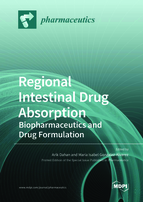Regional Intestinal Drug Absorption: Biopharmaceutics and Drug Formulation
A special issue of Pharmaceutics (ISSN 1999-4923). This special issue belongs to the section "Biopharmaceutics".
Deadline for manuscript submissions: closed (20 March 2020) | Viewed by 60719
Special Issue Editors
Interests: oral absorption; intestinal permeability methods; dissolution; drug formulation; PK modelling; dissolution apparatus
Special Issues, Collections and Topics in MDPI journals
Interests: oral drug absorption; intestinal permeability; drug solubility; drug dissolution; biopharmaceutics classification system (BCS); drug delivery and targeting
Special Issues, Collections and Topics in MDPI journals
Special Issue Information
Dear Colleagues,
The oral route offers undeniable advantages over other administration routes, because it is the most physiological, easiest and, therefore, the preferred option by the patients.
After the oral administration of a drug, the small intestine will be the main site of absorption, but different environments can be observed in the different regional intestinal segments due to for instance different transporters, fluids pH and composition, intestinal mucosa anatomy, tight junction’s resistance, metabolic enzyme distribution and microbiota presence. The transit through these different environments determines differences in absorption rate and extent as the formulation behaviour i.e disintegration/dissolution/precipitation depends on those changing luminal factors.
Nowadays, many experimental alternative methods have been developed to predict intestinal behaviour of formulations in human as in vitro, in situ or ex vivo methods. Their main purpose is to reduce or even replace human experiments. Nevertheless, the adequate predictability of those methods relies on a more accurate knowledge of the segmental intestinal differences and despite of our better knowledge of human intestinal anatomy and physiology there are still many gaps to fill on the overall picture.
Among the later ones there are many new in vitro dissolution systems, from mono to multicompartmental dynamics models. These models increase technological complexity by adding mechanical forces, combining dissolution and absorption models and simulating continuous changes in luminal conditions. These multicompartment systems could reproduce in vitro the supersaturation or precipitation processes that can significantly affect the bioavailability of the drug. Moreover, these systems generate usually better correlations between in vitro and in vivo values (IVIVC).
The objective of this special issue is to cover the later developments either in animal models of human segmental differences to in vitro mechanical devices mimicking the intestine and its dynamic changes as well as all the diagnostic/analytical tools used on the study of the different segments. The applications of those technologies and the review of the unmet needs are also welcome.
Prof. Dr. Maria Isabel Gonzalez-Alvarez
Prof. Dr. Arik Dahan
Guest Editor
Manuscript Submission Information
Manuscripts should be submitted online at www.mdpi.com by registering and logging in to this website. Once you are registered, click here to go to the submission form. Manuscripts can be submitted until the deadline. All submissions that pass pre-check are peer-reviewed. Accepted papers will be published continuously in the journal (as soon as accepted) and will be listed together on the special issue website. Research articles, review articles as well as short communications are invited. For planned papers, a title and short abstract (about 100 words) can be sent to the Editorial Office for announcement on this website.
Submitted manuscripts should not have been published previously, nor be under consideration for publication elsewhere (except conference proceedings papers). All manuscripts are thoroughly refereed through a single-blind peer-review process. A guide for authors and other relevant information for submission of manuscripts is available on the Instructions for Authors page. Pharmaceutics is an international peer-reviewed open access monthly journal published by MDPI.
Please visit the Instructions for Authors page before submitting a manuscript. The Article Processing Charge (APC) for publication in this open access journal is 2900 CHF (Swiss Francs). Submitted papers should be well formatted and use good English. Authors may use MDPI's English editing service prior to publication or during author revisions.
Keywords
- intestinal permeability
- segmental-dependent permeability
- segmental-dependent dissolution
- mono and multicompartment apparatus
- dissolution specifications








